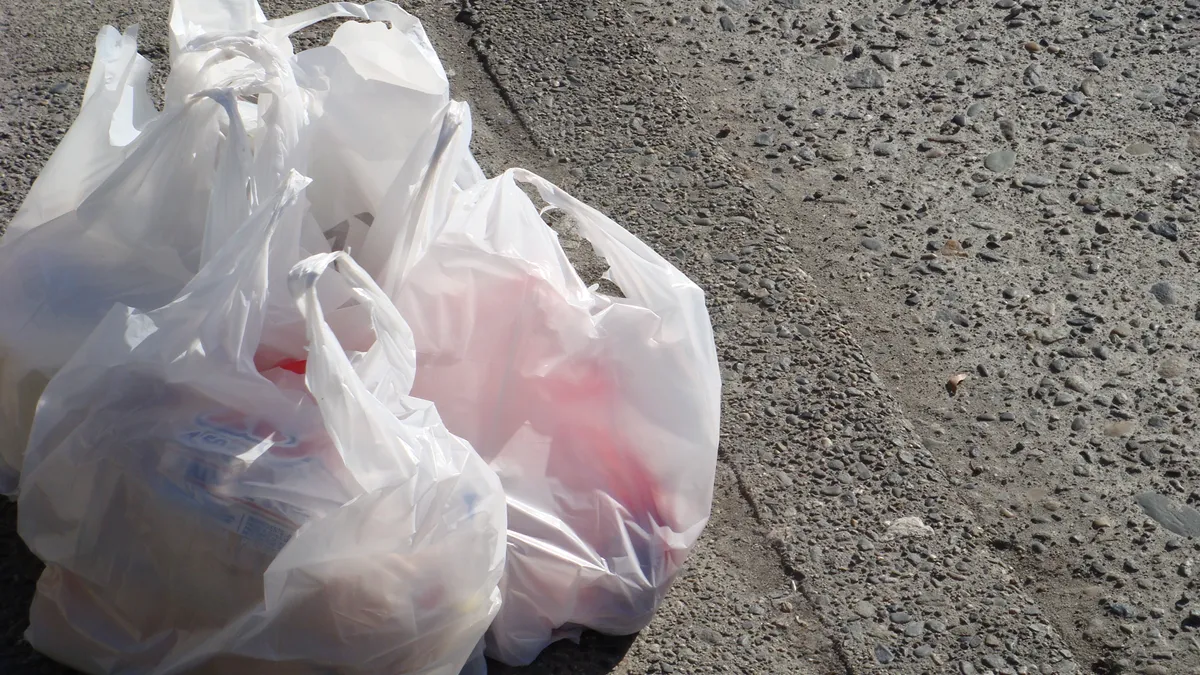Clarification: A previous version of this article used imprecise language to describe the varying comparison methodologies.
Dive Brief:
- Last month, Californians Against Waste (CAW) issued a press release touting a 72% drop in plastic bag litter counted during the annual California Coastal Cleanup Day since 2010. Plastics manufacturer Novolex, through its Bag the Ban group, was quick to question this because the data didn't begin differentiating between "plastic bags" and "plastic grocery bags" until 2013. Supporters were encouraged to call out this "dishonest data" that entered "fake news territory" via article comments, Facebook and Twitter.
- CAW's Executive Director Mark Murray said he took this into account by averaging the percentage of non-grocery plastic bags within the overall data that was collected since 2013 and subtracting that number from the 2010 statistic before making a comparison. As for the critique that bag litter appeared to be decreasing prior to the statewide ban taking effect in 2016, Murray said this was due in part to local ordinances already in effect for many coastal municipalities.
- While the bag classification criticism appears unfounded, there may have been a more precise methodology available. According to Steven Stein, an environmental scientist specializing in litter research, CAW's approach was "problematic." He said a more statistically accurate method would be to subtract the average percentage split of grocery versus non-grocery plastic bags, rather than the total amount of bags. This is because cleanup data has too many variables related to weather, coverage area and volunteer numbers. Using that method, the percentage reduction would be closer to 60%.
Dive Insight:
Plastic bag politics can be intense, and California has been the epicenter of debate for years. The state's bag policy, SB 270, only went into effect after a ballot referendum last fall. Now, the packaging industry is striving to downplay the significance of the bill to discourage others from following California's lead.
Tracking the effects of such policies can be difficult, as the latest Ocean Conservancy data estimates that bags accounted for about 2% of all litter collected during the International Coastal Cleanup in 2016. Yet bags can also turn up in non-coastal areas, get caught in storm drains and become a time-consuming nuisance for MRFs.
With all of this in mind, and the fact that many large California cities already had bag policies prior to 2016, it's unclear why CAW chose to commemorate the policy's one-year anniversary by making a 2010 coastal data comparison.
"I don't know that we need to prove anything. The bottom line is there's fewer single use plastic grocery bags being littered today. No matter how you measure it there are fewer single use plastic bags being littered," said Murray.
Because the role of bags as litter is a common talking point for supporters of regulation, this area has gotten especially granular. Bag proponents can readily cite litter studies from other states such as Florida and Texas where the percentage of bag litter decreased without policies. Other studies, from cities such as San Jose, CA, can appear to show policy results, but may be harder to cite based on further analysis.
Novolex will readily admit that banning bags reduces the number of bags in the world, but disputes whether bags were ever that much of a problem in the first place for California or anywhere else.
"Those numbers actually are favorable to the position that this doesn't do anything," said Phil Rozenski, senior director of sustainability for Novolex, referring to CAW's data presentation. "If they're applauding that status quo, the law was for nothing other than the money it took from the public."
Rozenski and his company are happy to critique the California policy, though because of the way it was written, they may also not be losing that much money because of it. According to Murray, and ongoing news of acquisitions from Novolex itself, the company has stepped in to fill the market for thicker reusable plastic bags. When asked about this, Rozenski repeatedly mentioned the inefficacy of SB 270 and did not directly address the question.
As the debate continues to play out over how packaging ordinances should be crafted — or whether they should be allowed to exist in the first place — this data dispute may become a more common talking point. With policies under consideration throughout the country, particularly in the Northeast, both sides will be looking for new statistical ways to prove their position in what is often a more subjective discussion about how bags embody consumer culture itself.











